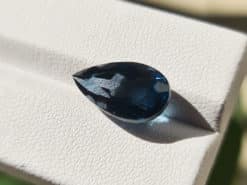Kornerupine

Kornerupine is also called Prismatine. It is a rare boro-silicate mineral with the formula (Mg,Fe2+)4(Al,Fe3+)6(SiO4,BO4)5(O,OH)2.
Buy natural gemstones in our gem shop
Kornerupine gemstone
It crystallizes in the orthorhombic – dipyramidal crystal system as brown, green, also yellow to colorless slender tourmaline like prisms or in massive fibrous forms.
First of all, It has a Mohs hardness of 7. Another, a specific gravity of 3.3 to 3.34. Furthermore, Its indices of refraction are nα=1.660 – 1.671, nβ=1.673 – 1.683 and nγ=1.674 – 1.684.
It occurs in boron-rich volcanic and also sedimentary rocks which have undergone high grade metamorphism. We also found it in metamorphosed anorthosite complexes.
Kornerupine is commonly found with sapphirine, also cordierite, spinel, corundum, tourmaline, grandidierite, dumortierite, kyanite, sillimanite, andalusite, biotite, phlogopite, magnetite, ilmenite, hematite, rutile.
Kornerupine is valuable as a gemstone when it is translucent green to yellow shades. The emerald green varieties are especially sought after. It forms a solid solution series with prismatine. Strongly pleochroic, it appears green or reddish brown when viewed from different directions. It has a vitreous luster.
It was first described in 1884 for an occurrence in Fiskernæs in southwest Greenland. The name kornerupine comes from the Danish geologist, Andreas Nikolaus Kornerup (1857–1883). It was not until 1912 that gem-quality material was found. It remains uncommon to this day.
Kornerupine rough sources
Current sources of gem quality crystals are:
- Ivohibe District, Horombe Region, Fianarantsoa Province, Madagascar.
- Mogok Township, Pyin-Oo-Lwin District, Mandalay Division, Myanmar.
- Matara District, Southern Province, Sri Lanka.
- Lelatema Mts, Simanjiro District, Manyara Region, Tanzania.
- We also found some deposits in Canada, Kenya, and South Africa.
We can confused Kornerupine with others gemstones.
Here are the key separations properties:
- Axinite: color, pleochroism, spectrum, optic figure (possibly).
- Spodumene: optic sign, SC, optic figure (possibly), fluorescence.
- Diopside: birefringence, optic sign, pleochroism, color (possibly), spectrum (possibly).
- Tourmaline: RI, SC, birefringence, optic character, spectrum.
- Sinhalite: RI, SC, birefringence, spectrum.
- Enstatite: spectrum, optic sign, optic figure (possibly).
Kornerupine meaning and healing properties benefits
The following section is pseudo scientific and based on cultural beliefs.
The stone has meaning and properties of reducing ups and downs of emotion. It is a healing gemstone that can relieve stress stored inside you. It will give you vitality when you feel down and cool you down when you are angry. This gemstone will be useful to keep your mind peaceful.
Kornerupine from Madagascar
FAQ
What is natural kornerupine gem?
A rare mineral occasionally used as a gemstone. It appears frequently in parcels from Ceylon and may be confused with beryl, peridot, topaz, or quartz. The stone is strongly pleochroic with dark reddish brown and yellow green as the predominant colors from Ceylon.
















